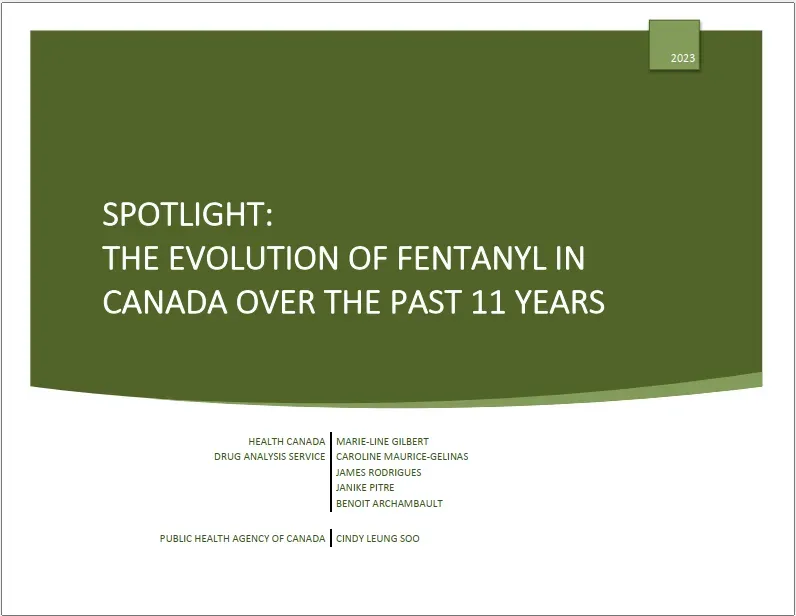Fentanyl production in Canada is an emerging concern as authorities grapple with the potential for increased trafficking of this potent opioid. As U.S. officials intensify efforts to secure the southern border against illegal drug flow, attention has started to shift northward, raising alarms about the implications for Canada drug laws. With reports suggesting that if the U.S. effectively cuts off routes from Mexico, illicit manufacturing could ramp up in Canadian facilities, the stakes have never been higher. The optimization of border security between the U.S. and Canada will play a crucial role in determining the extent of fentanyl’s infiltration into North America. As policymakers respond to this evolving threat, understanding the dynamics of fentanyl trafficking becomes vital for both countries.
The production of synthetic opioids, particularly a substance like fentanyl, is increasingly coming under scrutiny in Canada as drug enforcement agencies anticipate a rise in its manufacture. With a heightened focus on the security of the U.S.-Canada border, discussions around illicit drug trafficking are gaining traction. As Canada navigates complex drug laws, the potential for clandestine labs to spring up poses significant challenges. This situation not only calls for robust policy responses but also for enhanced cooperation between nations to combat the trafficking of dangerous substances. Understanding the gravity of this issue is paramount for maintaining public health and safety in both countries.
The Current State of Fentanyl Trafficking in Canada
Fentanyl trafficking has recently gained attention due to an increase in opioid-related deaths across North America. While Canada has, until now, been perceived more as a transit country rather than a primary source of fentanyl, indications suggest that this status could shift. The lack of significant fentanyl exports from Canada has allowed authorities to maintain a sense of control over the illegal drug flow. However, changing dynamics at the U.S.-Canada border, particularly with enhanced security measures aimed at curbing drug trafficking, could create new challenges for Canadian policymakers.
As the U.S. government intensifies its efforts to secure the southern border with Mexico, a potential consequence could be the migration of fentanyl production to Canada. Enhanced border security may not eliminate the drug problem but could redirect traffickers toward alternative pathways, making Canada a more attractive location for illicit activities. Consequently, if Canadian law enforcement agencies do not adapt to these emerging threats, it’s plausible that the landscape of fentanyl trafficking could evolve significantly, with local producers stepping into the breach.
Fentanyl Production: A Growing Concern in Canada
The concerns surrounding fentanyl production in Canada are underscored by the substance’s lethality and its rapid proliferation across the continent. While Canadian authorities have historically focused on synthesis and distribution patterns linked to Mexico, there is an increasing need to address local production capabilities. With legislative updates and an emphasis on tackling opioid crises, Canadian drug laws may become more stringent, aiming to curtail any domestic fentanyl manufacturing that could potentially flood into the U.S.
Moreover, the shift from Mexican to Canadian fentanyl production poses significant implications for U.S. border security. As more synthetic opioids enter the Canadian marketplace, local gangs or organized crime syndicates may attempt to exploit regulatory gaps to manufacture and distribute fentanyl. This escalation could lead to intensified collaboration between U.S. and Canadian enforcement agencies to combat the surge of illegal drugs. Proactive measures and effective bilateral agreements will be crucial in curbing any potential increase in fentanyl production within Canada.
The Role of Canada Drug Laws in Combatting Fentanyl Production
Canada’s drug laws have historically been viewed as more lenient than those in the U.S., leading to a perception that the country is a safe haven for certain drug-related practices. However, as fentanyl production rises in potential risk, Canadian lawmakers have begun reviewing and updating existing regulations to strengthen their stance against illegal drug trade. The implementation of stricter penalties for fentanyl manufacturers and traffickers could serve as a deterrent to those contemplating entering the market for synthetic opioids.
These revised drug laws not only aim to protect public health but also establish a firmer legal framework to prosecute individuals involved in illicit fentanyl production. Ensuring that legislation keeps pace with emerging drug trends will be crucial in maintaining a secure and healthy society. As enforcement agencies focus on disrupting the illegal drug flow, balancing effective legal measures with public health initiatives remains essential for combatting the potential threat of increased fentanyl production in Canada.
The Impact of U.S.-Canada Border Security on Fentanyl Trade
U.S.-Canada border security plays a pivotal role in shaping the dynamics of illicit drug trafficking, including fentanyl. As both nations strengthen their border control measures in response to surging opioid crises, any significant changes to these security protocols could impact drug flows between the two countries. Enhanced surveillance technologies and increased manpower aim to intercept illegal drugs before they cross the border, and this creates a pressure point for traffickers who may seek alternative methods for drug distribution.
If the U.S. effectively enhances its border security, there is a chance that traffickers will pivot towards Canadian production to meet the insatiable demand for fentanyl in the U.S. This translates into an urgent need for Canadian authorities to brace for potential shifts in trafficking patterns and to establish cooperative security efforts with their U.S. counterparts. Strengthening intelligence sharing and joint operations could provide a critical line of defense against the impending increase in fentanyl production in Canada.
Understanding the Motivations Behind Fentanyl Trafficking
The motivations behind fentanyl trafficking are multi-faceted, often driven by high profitability and demand. Traffickers seek to capitalize on the opioid crisis by supplying powerful substances like fentanyl, which can yield substantial profits with relatively low production costs. The desperation of addiction in urban areas presents a lucrative market for traffickers, which may incentivize them to pursue production locations that offer less risk, such as Canada.
Additionally, the perceived barriers to entry within Canada’s drug production landscape may encourage illegal activities. As current legislation struggles to keep pace with the sophistication of synthetic drug production techniques, opportunities for illicit operations may arise. Understanding these motivations is essential for the formulation of effective policies aimed at dismantling trafficking networks and preventing fentanyl production before it becomes entrenched in local communities.
Community Responses to Fentanyl Production Concerns
Local communities in Canada have become increasingly aware of the potential threats posed by emerging fentanyl production. Grassroots organizations and advocacy groups have risen to the occasion, focusing their efforts on education and prevention strategies to combat substance abuse. Community-led initiatives aim to confront the realities of fentanyl trafficking, pressing local governments for prompt action in enforcing stricter drug laws and increasing resources for addiction recovery.
Engaging community members in discussions about fentanyl and its dangers facilitates a multi-dimensional approach to addressing drug issues. By fostering awareness and encouraging open dialogue, communities can better support those struggling with addictions and push for comprehensive drug policy reform that addresses both public health and safety aspects. This proactive involvement lays the groundwork for future resilience against the potential surge in fentanyl production in Canada.
Policy Recommendations for Managing Fentanyl Risks
Given the potential shift of fentanyl production to Canada, it is critical for policymakers to develop a robust strategy that addresses risk management effectively. This may include implementing stricter regulations on precursor chemicals used in drug synthesis, as well as enhancing tracking systems for these substances to prevent their diversion to illicit markets. Additionally, establishing clear protocols for cross-border cooperation can ensure that both Canada and the U.S. remain vigilant against evolving drug threats.
Moreover, investing in education and treatment programs will help mitigate the demand side of the fentanyl issue. By prioritizing resources toward addiction recovery services and elevating public awareness campaigns, governments can reduce the overall appeal of synthetic opioids among vulnerable populations. With a collaborative approach that emphasizes prevention, enforcement, and treatment, Canada can proactively address the potential rise in fentanyl production and safeguard its communities.
Fentanyl’s Impact on Public Health: A Canadian Perspective
The impact of fentanyl extends beyond law enforcement and illegal trafficking—it significantly affects public health. With an increasing number of overdose deaths linked to fentanyl, Canadian public health systems are under pressure to respond effectively. As the crisis unfolds, health professionals are striving to understand the implications of fentanyl misuse and to develop interventions aimed at curbing its devastating effects on communities.
In Canada, healthcare campaigns focusing on harm reduction strategies aim to educate the public about the risks associated with fentanyl. Initiatives such as supervised consumption sites and naloxone distribution are crucial components of these prevention efforts. By equipping individuals with knowledge and resources, Canada seeks to mitigate the harmful consequences of fentanyl, ultimately fostering a healthier society despite the potential challenges posed by future production shifts.
The Future of Fentanyl Trafficking and Production in Canada
As we look towards the future, the trajectory of fentanyl trafficking and production in Canada remains uncertain. Several factors will influence these trends, such as governmental response to changes in cross-border drug flows, advances in drug enforcement protocols, and the adaptability of trafficking organizations. Canadian authorities will need to remain vigilant and responsive to these developments to prevent becoming a significant source of fentanyl.
Moreover, establishing a coordinated North American strategy to combat fentanyl production will be imperative. By sharing intelligence and resources among U.S. and Canadian agencies, the two nations can create a formidable front against this rising threat. Collaborative law enforcement and public health initiatives will be key components of a future glossary for success in managing the complexities of fentanyl trafficking and production in Canada.
Frequently Asked Questions
What is the current state of fentanyl production in Canada?
As of now, there is no evidence of significant fentanyl production in Canada. However, the situation may change if the United States reinforces its border security with Mexico, which has previously been the primary route for fentanyl trafficking.
How might U.S. border security changes affect fentanyl production in Canada?
If the U.S. manages to significantly seal its border with Mexico, there is a risk that fentanyl production may shift towards Canada. This could lead to increased trafficking and associated challenges in Canada.
What measures has Canada taken to combat fentanyl trafficking?
In response to concerns about fentanyl trafficking, Canada has implemented stricter laws and increased enforcement efforts aimed at reducing the flow of illegal drugs, including fentanyl, across its borders.
Are Canadian drug laws effective in preventing fentanyl production?
Canada’s drug laws have been strengthened to tackle the issue of fentanyl production and trafficking. However, the effectiveness of these laws continues to evolve as the landscape of illegal drug flow changes.
What role does Canada play in the U.S. fentanyl crisis?
While there is currently limited evidence connecting Canada directly to the U.S. fentanyl crisis, concerns remain that increased production or trafficking could arise if the U.S. closes off its southern border.
What are the implications of fentanyl production moving to Canada?
If fentanyl production shifts to Canada, it could lead to increased illegal drug flow into the U.S., further straining cross-border relations and necessitating enhanced cooperation on drug enforcement between the two countries.
How has public perception in Canada changed regarding fentanyl production?
Public perception regarding fentanyl production in Canada has become more cautious, with increased awareness of the potential implications for public health and safety as discussions around drug trafficking have intensified.
What challenges does Canada face in addressing fentanyl trafficking?
Canada faces several challenges in combating fentanyl trafficking, including resource allocation for law enforcement, the need for inter-agency collaboration, and addressing the public health crisis associated with opioid use.
Can Canada completely eliminate fentanyl production?
While Canada can take significant steps to reduce and control fentanyl production, completely eliminating it may prove challenging due to the nature of illegal drug markets and the demand for opioids.
What is the future outlook for fentanyl production in Canada?
The future of fentanyl production in Canada remains uncertain, heavily influenced by changes in U.S. border security, drug enforcement policies, and the ongoing demand for illicit drugs on both sides of the border.
| Key Point | Details |
|---|---|
| Increased Fentanyl Production | Concerns that more production may shift to Canada if U.S. border security improves. |
| Current Situation | There is currently no significant flow of fentanyl from Canada to the U.S. |
| Government Action | Canada has implemented measures to combat the illegal drug trade in response to U.S. concerns. |
| Recent Political Context | The issue gained attention following claims by U.S. President Donald Trump regarding drug trafficking. |
Summary
Fentanyl production in Canada is a growing concern amidst changing border dynamics with the United States. Although there are currently no significant flows of fentanyl from Canada, potential shifts in drug production to Canada could occur if U.S. border security enhances. The Canadian government is proactively seeking to address this issue through various measures aimed at controlling illegal drug trafficking, especially in light of recent political statements by U.S. leaders that emphasize the drug epidemic.




